cooling Alfa Romeo Stelvio 2019 Owner's Manual
[x] Cancel search | Manufacturer: ALFA ROMEO, Model Year: 2019, Model line: Stelvio, Model: Alfa Romeo Stelvio 2019Pages: 244, PDF Size: 4.95 MB
Page 36 of 244
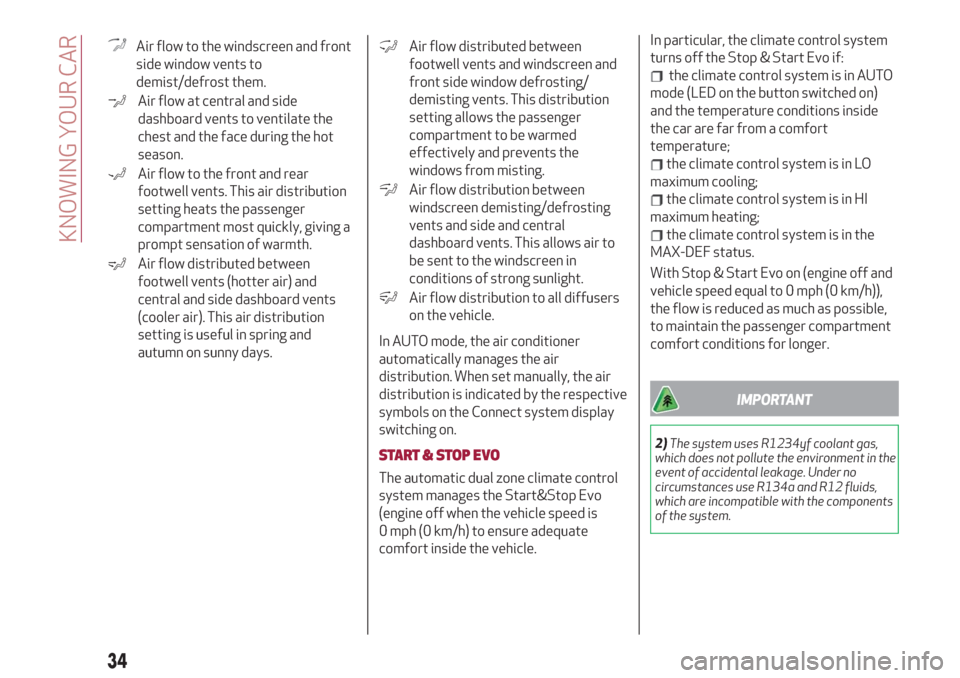
Air flow to the windscreen and front
side window vents to
demist/defrost them.
Air flow at central and side
dashboard vents to ventilate the
chest and the face during the hot
season.
Air flow to the front and rear
footwell vents. This air distribution
setting heats the passenger
compartment most quickly, giving a
prompt sensation of warmth.
Air flow distributed between
footwell vents (hotter air) and
central and side dashboard vents
(cooler air). This air distribution
setting is useful in spring and
autumn on sunny days.
Air flow distributed between
footwell vents and windscreen and
front side window defrosting/
demisting vents. This distribution
setting allows the passenger
compartment to be warmed
effectively and prevents the
windows from misting.
Air flow distribution between
windscreen demisting/defrosting
vents and side and central
dashboard vents. This allows air to
be sent to the windscreen in
conditions of strong sunlight.
Air flow distribution to all diffusers
on the vehicle.
In AUTO mode, the air conditioner
automatically manages the air
distribution. When set manually, the air
distribution is indicated by the respective
symbols on the Connect system display
switching on.
START & STOP EVO
The automatic dual zone climate control
system manages the Start&Stop Evo
(engine off when the vehicle speed is
0 mph (0 km/h) to ensure adequate
comfort inside the vehicle.In particular, the climate control system
turns off the Stop & Start Evo if:
the climate control system is in AUTO
mode (LED on the button switched on)
and the temperature conditions inside
the car are far from a comfort
temperature;
the climate control system is in LO
maximum cooling;
the climate control system is in HI
maximum heating;
the climate control system is in the
MAX-DEF status.
With Stop & Start Evo on (engine off and
vehicle speed equal to 0 mph (0 km/h)),
the flow is reduced as much as possible,
to maintain the passenger compartment
comfort conditions for longer.
IMPORTANT
2)The system uses R1234yf coolant gas,
which does not pollute the environment in the
event of accidental leakage. Under no
circumstances use R134a and R12 fluids,
which are incompatible with the components
of the system.
34
KNOWING YOUR CAR
Page 166 of 244
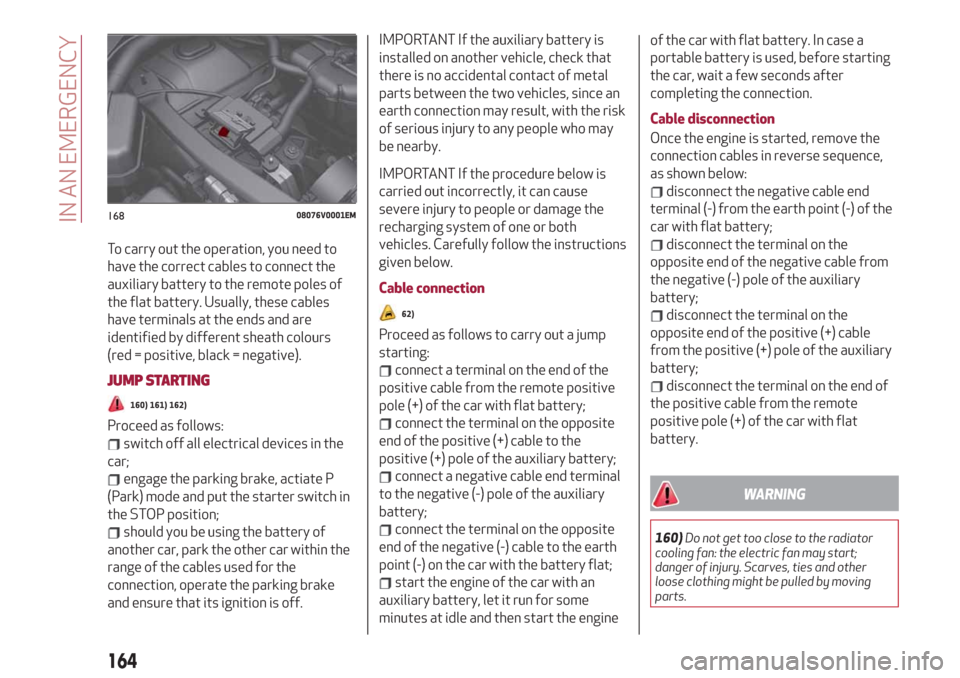
To carry out the operation, you need to
have the correct cables to connect the
auxiliary battery to the remote poles of
the flat battery. Usually, these cables
have terminals at the ends and are
identified by different sheath colours
(red = positive, black = negative).
JUMP STARTING
160) 161) 162)
Proceed as follows:
switch off all electrical devices in the
car;
engage the parking brake, actiate P
(Park) mode and put the starter switch in
the STOP position;
should you be using the battery of
another car, park the other car within the
range of the cables used for the
connection, operate the parking brake
and ensure that its ignition is off.
IMPORTANT If the auxiliary battery is
installed on another vehicle, check that
there is no accidental contact of metal
parts between the two vehicles, since an
earth connection may result, with the risk
of serious injury to any people who may
be nearby.
IMPORTANT If the procedure below is
carried out incorrectly, it can cause
severe injury to people or damage the
recharging system of one or both
vehicles. Carefully follow the instructions
given below.
Cable connection
62)
Proceed as follows to carry out a jump
starting:
connect a terminal on the end of the
positive cable from the remote positive
pole (+) of the car with flat battery;
connect the terminal on the opposite
end of the positive (+) cable to the
positive (+) pole of the auxiliary battery;
connect a negative cable end terminal
to the negative (-) pole of the auxiliary
battery;
connect the terminal on the opposite
end of the negative (-) cable to the earth
point (-) on the car with the battery flat;
start the engine of the car with an
auxiliary battery, let it run for some
minutes at idle and then start the engineof the car with flat battery. In case a
portable battery is used, before starting
the car, wait a few seconds after
completing the connection.
Cable disconnection
Once the engine is started, remove the
connection cables in reverse sequence,
as shown below:
disconnect the negative cable end
terminal (-) from the earth point (-) of the
car with flat battery;
disconnect the terminal on the
opposite end of the negative cable from
the negative (-) pole of the auxiliary
battery;
disconnect the terminal on the
opposite end of the positive (+) cable
from the positive (+) pole of the auxiliary
battery;
disconnect the terminal on the end of
the positive cable from the remote
positive pole (+) of the car with flat
battery.
WARNING
160)Do not get too close to the radiator
cooling fan: the electric fan may start;
danger of injury. Scarves, ties and other
loose clothing might be pulled by moving
parts.
16808076V0001EM
164
IN AN EMERGENCY
Page 179 of 244
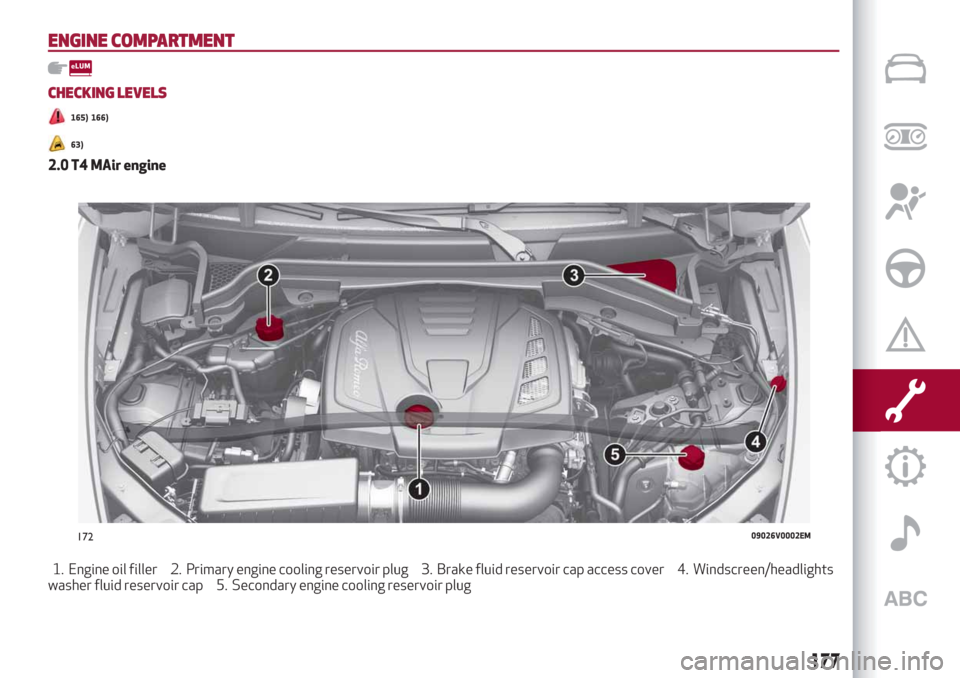
ENGINE COMPARTMENT
CHECKING LEVELS
165) 166)
63)
2.0 T4 MAir engine
1. Engine oil filler 2. Primary engine cooling reservoir plug 3. Brake fluid reservoir cap access cover 4. Windscreen/headlights
washer fluid reservoir cap 5. Secondary engine cooling reservoir plug
17209026V0002EM
177
Page 180 of 244

2.0 T4 MAir engine (right-hand drive)
1. Engine oil filler 2. Primary engine cooling reservoir plug 3. Brake fluid reservoir cap access cover 4. Windscreen/headlights
washer fluid reservoir cap 5. Secondary engine cooling reservoir plug
17309026V0003EM
178
SERVICING AND CARE
Page 181 of 244
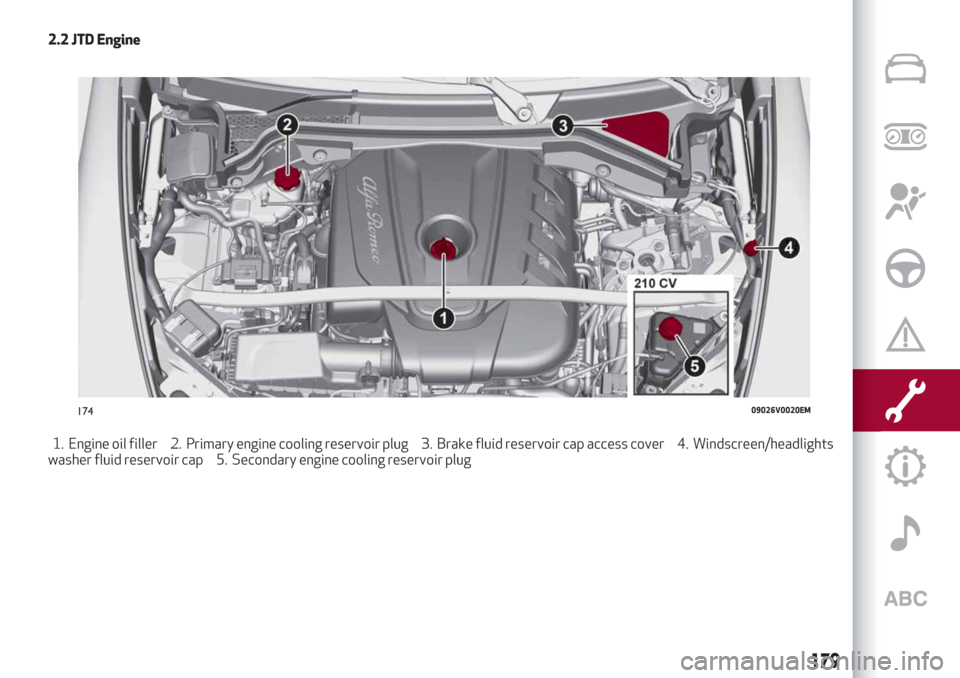
2.2 JTD Engine
1. Engine oil filler 2. Primary engine cooling reservoir plug 3. Brake fluid reservoir cap access cover 4. Windscreen/headlights
washer fluid reservoir cap 5. Secondary engine cooling reservoir plug
17409026V0020EM
179
Page 182 of 244
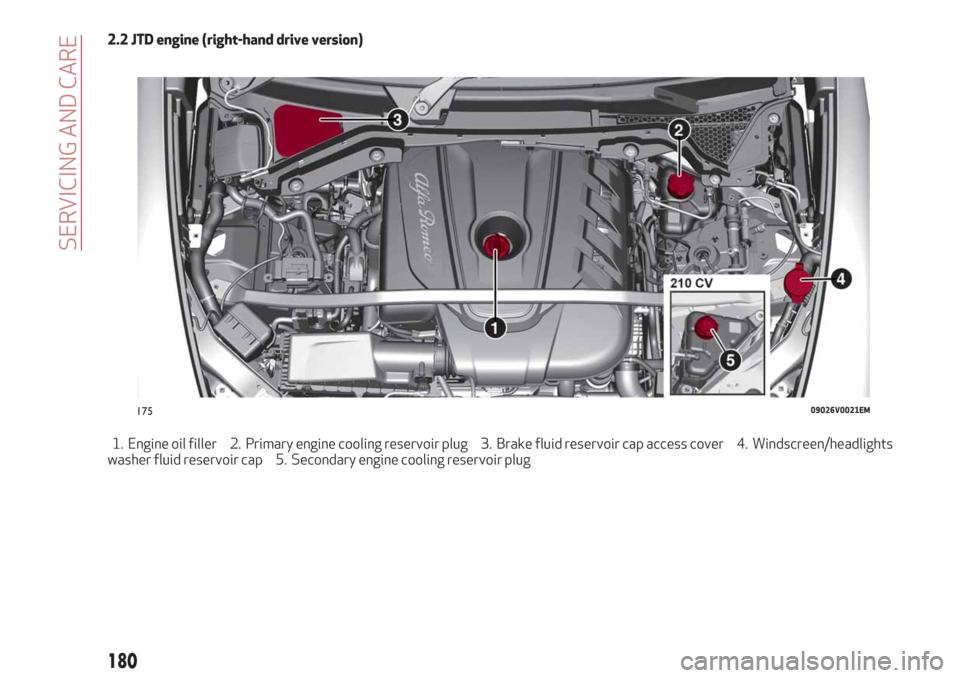
2.2 JTD engine (right-hand drive version)
1. Engine oil filler 2. Primary engine cooling reservoir plug 3. Brake fluid reservoir cap access cover 4. Windscreen/headlights
washer fluid reservoir cap 5. Secondary engine cooling reservoir plug
17509026V0021EM
180
SERVICING AND CARE
Page 185 of 244
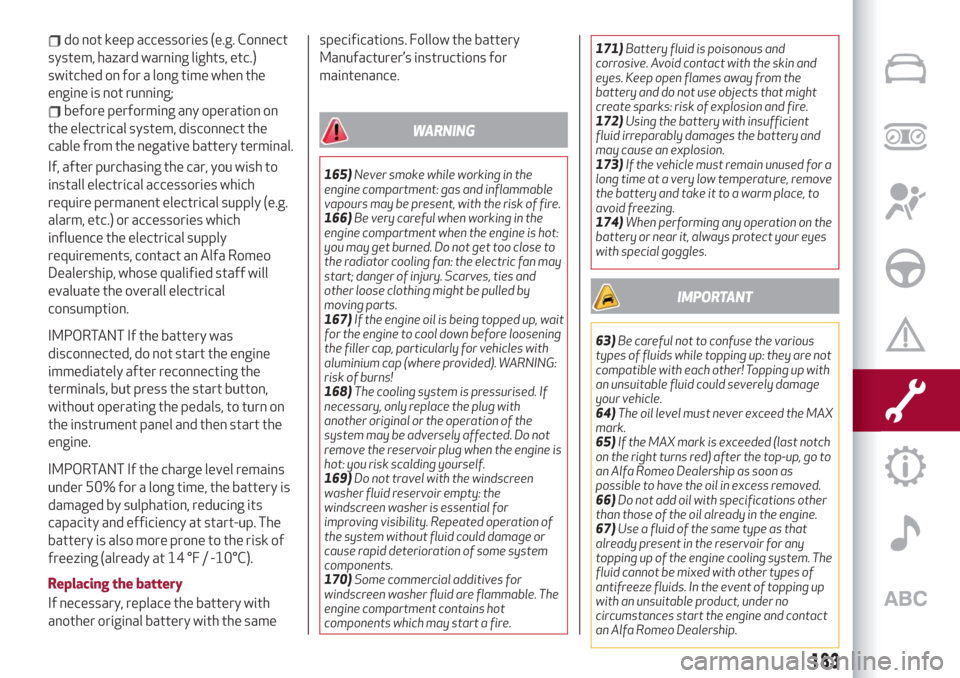
do not keep accessories (e.g. Connect
system, hazard warning lights, etc.)
switched on for a long time when the
engine is not running;
before performing any operation on
the electrical system, disconnect the
cable from the negative battery terminal.
If, after purchasing the car, you wish to
install electrical accessories which
require permanent electrical supply (e.g.
alarm, etc.) or accessories which
influence the electrical supply
requirements, contact an Alfa Romeo
Dealership, whose qualified staff will
evaluate the overall electrical
consumption.
IMPORTANT If the battery was
disconnected, do not start the engine
immediately after reconnecting the
terminals, but press the start button,
without operating the pedals, to turn on
the instrument panel and then start the
engine.
IMPORTANT If the charge level remains
under 50% for a long time, the battery is
damaged by sulphation, reducing its
capacity and efficiency at start-up. The
battery is also more prone to the risk of
freezing (already at 14 °F / -10°C).
Replacing the battery
If necessary, replace the battery with
another original battery with the samespecifications. Follow the battery
Manufacturer’s instructions for
maintenance.
WARNING
165)Never smoke while working in the
engine compartment: gas and inflammable
vapours may be present, with the risk of fire.
166)Be very careful when working in the
engine compartment when the engine is hot:
you may get burned. Do not get too close to
the radiator cooling fan: the electric fan may
start; danger of injury. Scarves, ties and
other loose clothing might be pulled by
moving parts.
167)If the engine oil is being topped up, wait
for the engine to cool down before loosening
the filler cap, particularly for vehicles with
aluminium cap (where provided). WARNING:
risk of burns!
168)The cooling system is pressurised. If
necessary, only replace the plug with
another original or the operation of the
system may be adversely affected. Do not
remove the reservoir plug when the engine is
hot: you risk scalding yourself.
169)Do not travel with the windscreen
washer fluid reservoir empty: the
windscreen washer is essential for
improving visibility. Repeated operation of
the system without fluid could damage or
cause rapid deterioration of some system
components.
170)Some commercial additives for
windscreen washer fluid are flammable. The
engine compartment contains hot
components which may start a fire.171)Battery fluid is poisonous and
corrosive. Avoid contact with the skin and
eyes. Keep open flames away from the
battery and do not use objects that might
create sparks: risk of explosion and fire.
172)Using the battery with insufficient
fluid irreparably damages the battery and
may cause an explosion.
173)If the vehicle must remain unused for a
long time at a very low temperature, remove
the battery and take it to a warm place, to
avoid freezing.
174)When performing any operation on the
battery or near it, always protect your eyes
with special goggles.
IMPORTANT
63)Be careful not to confuse the various
types of fluids while topping up: they are not
compatible with each other! Topping up with
an unsuitable fluid could severely damage
your vehicle.
64)The oil level must never exceed the MAX
mark.
65)If the MAX mark is exceeded (last notch
on the right turns red) after the top-up, go to
an Alfa Romeo Dealership as soon as
possible to have the oil in excess removed.
66)Do not add oil with specifications other
than those of the oil already in the engine.
67)Use a fluid of the same type as that
already present in the reservoir for any
topping up of the engine cooling system. The
fluid cannot be mixed with other types of
antifreeze fluids. In the event of topping up
with an unsuitable product, under no
circumstances start the engine and contact
an Alfa Romeo Dealership.
183
Page 204 of 244
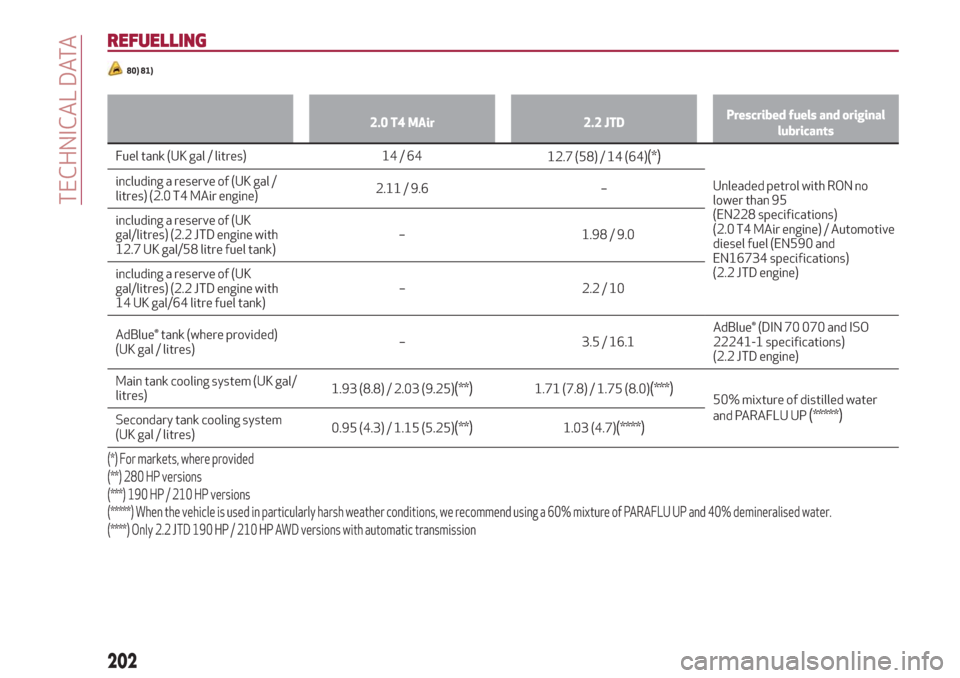
REFUELLING
80) 81)
2.0 T4 MAir 2.2 JTDPrescribed fuels and original
lubricants
Fuel tank (UK gal / litres) 14 / 64
12.7 (58) / 14 (64)(*)
Unleaded petrol with RON no
lower than 95
(EN228 specifications)
(2.0 T4 MAir engine) / Automotive
diesel fuel (EN590 and
EN16734 specifications)
(2.2 JTD engine) including a reserve of (UK gal /
litres) (2.0 T4 MAir engine)2.11 / 9.6 –
including a reserve of (UK
gal/litres) (2.2 JTD engine with
12.7 UK gal/58 litre fuel tank)– 1.98 / 9.0
including a reserve of (UK
gal/litres) (2.2 JTD engine with
14 UK gal/64 litre fuel tank)– 2.2 / 10
AdBlue® tank (where provided)
(UK gal / litres)– 3.5 / 16.1AdBlue® (DIN 70 070 and ISO
22241-1 specifications)
(2.2 JTD engine)
Main tank cooling system (UK gal/
litres)1.93 (8.8) / 2.03 (9.25)
(**)1.71 (7.8) / 1.75 (8.0)(***)50% mixture of distilled water
and PARAFLU UP(*****)Secondary tank cooling system
(UK gal / litres)0.95 (4.3) / 1.15 (5.25)(**)1.03 (4.7)(****)
(*) For markets, where provided
(**) 280 HP versions
(***) 190 HP / 210 HP versions
(*****) When the vehicle is used in particularly harsh weather conditions, we recommend using a 60% mixture of PARAFLU UP and 40% demineralised water.
(****) Only 2.2 JTD 190 HP / 210 HP AWD versions with automatic transmission
202
TECHNICAL DATA